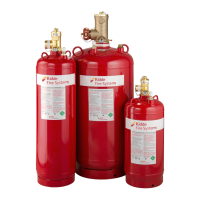MATERIAL SAFETY DATA SHEET
FM-200 (Fire Extinguishing Agent)
Revision Date: February 9, 2012 Page 3 of 6
8. EXPOSURE CONTROLS/PERSONAL PROTECTION
Engineering Control Measures
Use with adequate ventilation. There should be local procedures for the selection, training, inspection
and maintenance of this equipment. When used in large volumes or odor becomes apparent, use local
exhaust ventilation.
Respiratory Protection
Not normally required under conditions of use as a portable fire extinguisher. For other applications
creating oxygen deficient atmospheres, use a self contained breathing apparatus, as an air purifying
respirator will not provide protection.
Hand Protection
Wear rubber gloves. Avoid contact with skin.
Eye Protection
Chemical goggles or safety glasses with side shields. Avoid contact with eyes.
Body Protection
Normal work wear.
9.
PHYSICAL AND CHEMICAL PROPERTIES
Physical State
Liquefied gas under pressure
Color
Colorless
Odor
Odorless
Specific Gravity
1.46
Boiling Range/Point (°C/F)
-16.4
C/3
F
Flash Point (PMCC) (°C/F)
Not Flammable
Solubility in Water
260 mg/L
Vapor Density (Air = 1)
6.04
Vapor Pressure
58.8 psia @ 70
F
Gas Density
2.01 lb/ft
@ 70
F
Evaporation Rate
Not applicable
10. STABILITY AND REACTIVITY
Stability
Stable under normal conditions.
Conditions to Avoid
- Heat - High temperatures - Exposure to direct sunlight
Materials to Avoid
- powdered metals (ex. aluminum, zinc, etc.) - strong oxidizing agents – strong reducing agents – strong
alkalis
Hazardous Polymerization
Will not occur.
Hazardous Decomposition Products
- oxides of carbon - hydrogen fluoride

